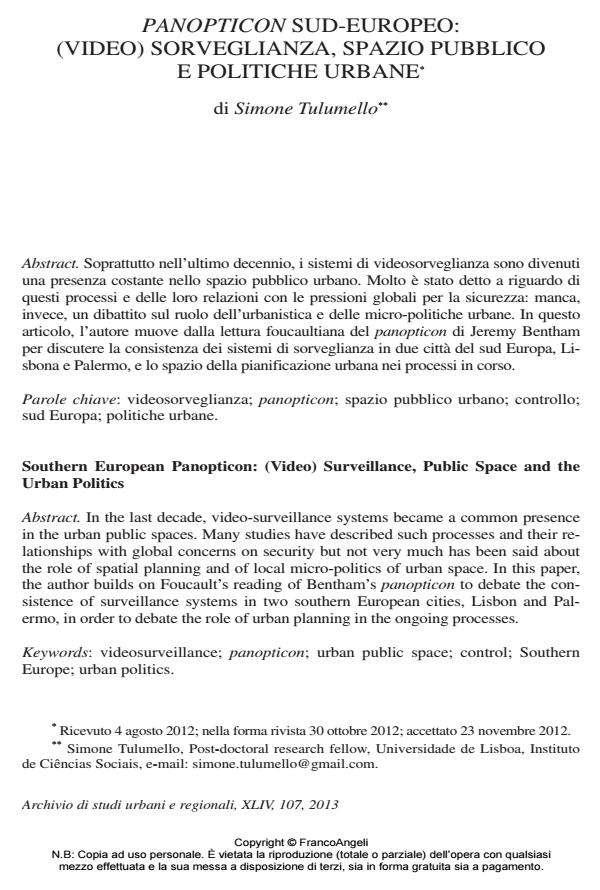Southern European Panopticon: (Video) Surveillance, Public Space and the Urban Politics
Journal title ARCHIVIO DI STUDI URBANI E REGIONALI
Author/s Simone Tulumello
Publishing Year 2013 Issue 2013/107
Language Italian Pages 22 P. 30-51 File size 1431 KB
DOI 10.3280/ASUR2013-107003
DOI is like a bar code for intellectual property: to have more infomation
click here
Below, you can see the article first page
If you want to buy this article in PDF format, you can do it, following the instructions to buy download credits

FrancoAngeli is member of Publishers International Linking Association, Inc (PILA), a not-for-profit association which run the CrossRef service enabling links to and from online scholarly content.
In the last decade, video-surveillance systems became a common presence in the urban public spaces. Many studies have described such processes and their relationships with global concerns on security but not very much has been said about the role of spatial planning and of local micro-politics of urban space. In this paper, the author builds on Foucault’s reading of Bentham’s panopticon to debate the consistence of surveillance systems in two southern European cities, Lisbon and Palermo, in order to debate the role of urban planning in the ongoing processes.
Keywords: Videosurveillance; panopticon; urban public space; control; Southern Europe; urban politics.
- Reconsidering neoliberal urban planning in times of crisis: urban regeneration policy in a “dense” space in Lisbon Simone Tulumello, in Urban Geography /2016 pp.117
DOI: 10.1080/02723638.2015.1056605 - From “Spaces of Fear” to “Fearscapes” Simone Tulumello, in Space and Culture /2015 pp.257
DOI: 10.1177/1206331215579716 - Dinâmicas sociogeográficas e políticas na Área Metropolitana de Lisboa em tempos de crise e de austeridade João Seixas, Simone Tulumello, Susana Corvelo, Ana Drago, in Cadernos Metrópole /2015 pp.371
DOI: 10.1590/2236-9996.2015-3404 - Fear, Space and Urban Planning Simone Tulumello, pp.55 (ISBN:978-3-319-43936-5)
Simone Tulumello, Panopticon sud-europeo: (video) sorveglianza, spazio pubblico e politiche urbane in "ARCHIVIO DI STUDI URBANI E REGIONALI" 107/2013, pp 30-51, DOI: 10.3280/ASUR2013-107003